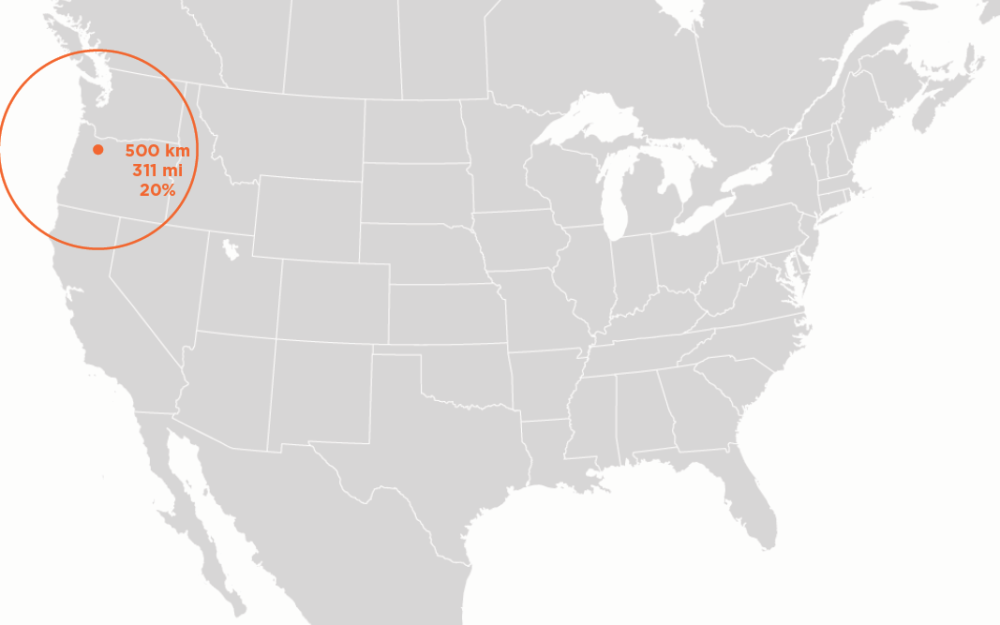DISTANCE MEASUREMENT
Distances from manufacturing locations to construction sites may be measured as the crow flies. Route mapping is also acceptable.

This map shows the area included within 500 kilometers (km) of a construction site in Portland, OR.
LOCAL MICROBUSINESSES
Independently Owned and Operated
A primary intent of the local microbusiness multiplier is to support businesses that are independent as well as locally owned and operated. An independently owned and operated business independently manages and controls the day-to-day operations of its own business and does not have a larger national, international, or other controlling entity or person involved in decision-making or providing financial backing.
Local Microbusiness
A Local Microbusiness exhibits all of the following attributes:
- Independently owned and operated (may be a sole proprietorship, partnership, corporation, or any other legal form in the country of operation);
- In at least one of the three fiscal years prior to the project team’s research and vetting of the product, has fewer than 10 employees or full-time equivalents (calculated during any pay period); and
- Located within 500km of the construction site.
MANUFACTURER LOCATION
The manufacturer location is where the final product is fabricated or assembled. A distribution facility does not qualify as a product’s manufacturing location.
MATERIALS CONSTRUCTION BUDGET
The Materials Construction Budget includes all costs for materials within the materials vetting scope and excludes labor, soft costs, and land. Product cost is based on the price of a product or material as it is delivered to the site. Delivery and installation charges are excluded from materials costs. The product or material cost may be based on actual or estimated costs according to the following guidelines:
- Teams are permitted to establish their total LBC project cost from a single milestone cost estimate (e.g., issued for 100% Guaranteed Maximum Price).
- Product cost, as delivered to the site, must be provided for each distinct product included in the project’s Materials Track Table. Product costs may be derived from any or a combination of the following:
- Actual reported product cost from the subcontractor/supplier;
- Industry-standard construction cost database, such as RS Means, with localized multipliers, cost estimator, or general contractor’s construction estimate;
- A default 45/55 percent labor and materials split when a full contract value is known that covers uniform products or materials (e.g., windows or custom-fabricated steel) sourced from a single final point of assembly.
- All estimated costs must be based on a single timeframe. For example, if the 100% GMP estimate is dated July 2023, then the estimates for individual products from, for example, RS Means, must reflect its estimates for July 2023 or as close to the date as reasonable.
- Costs reported for products with FSC or salvage claims contributing to the wood sourcing thresholds in this Imperative or in I14 Responsible Sourcing must be based on receipts documenting them as either salvage or FSC-certified with a complete Chain of Custody.
For donated or discounted materials, project teams can choose to report actual cost to the project or replacement/full purchase prices. Any of the following sources for pricing data are acceptable: the manufacturer, construction estimating team, invoices, product representatives, or pricing for comparable products as an indication of the replacement/full-price cost.
MULTIPLIERS
The following items may be doubled in cost calculations, at the project team’s discretion:
- Declare products
- Living Product Challenge products
- Salvaged materials or products
- Products procured from Local Microbusinesses
The multiplier is not applicable under all Imperatives; eligible product costs may only be doubled in sourcing distance calculations for Imperative 12 Responsible Materials (C6) and Imperative 15 Living Economy Sourcing. For example, an FSC wood product that has a Declare label and is sourced within 500km of the site may be counted double for the I12 (C6) or I15 sourcing distance calculations, but only once for the I12 and I14 FSC percentage compliance calculations.
NATURAL MATERIALS
Certain natural materials may include labor in their calculation. Examples include rammed earth and straw bale construction, where on-site labor accounts for the majority of project cost and materials are extremely low cost and locally supplied. Higher cost products with more standard labor costs (e.g., stone cladding or counters) are not allowed to have labor included in their costs.
REMOTE LOCATIONS
See Approved Regional Equivalencies for distance zones applicable to Oceania.
SOURCING DOCUMENTATION
For products with a Declare label or Living Product certification, the sourcing location may be taken directly from the Declare label or LPC database. When there is only one manufacturing site listed on the label, no additional documentation of the manufacturing location is needed. If there is more than one site listed, the manufacturer or vendor must provide written confirmation of the site of final manufacture.



